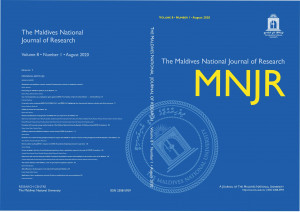Abstract
This study aims to assess the Indoor Air Quality (IAQ) inside a one room apartment of about 240 square feet in the Henveiru district in Male’, Maldives. Concentrations of Particulate Matter (PM2.5), one of the most detrimental air pollutants, were measured every 15 minutes from 10-09-2021 to 18-12-2021 using low-cost PM BlueSky sensors inside the building (indoor) and simultaneously outdoor, about 300m away from the indoor sensor. The BlueSky monitors were co-located and harmonized before starting the monitoring. The mean concentrations observed indoor and outdoor for 93 days were 10.1±13.1 µg/m3 and 6.5±4.9 µg/m3, respectively. Both results surpass the annual average of 5 µg/m3 guideline of World Health Organization (WHO). The number of days that surpassed the 24-hour WHO limit was 9 for indoor and 7 for outdoors. The diurnal pattern of PM2.5 shows a drastic accumulation of the pollutant inside the building when the only available ventilation (the window) was closed, which was identified at night and also during the daytime. The recorded PM2.5 levels also aligned with household activities like cooking, cleaning, and dusting. There was a significant moderate correlation (r= 0.48) between outdoor and indoor PM2.5. The I/O ratio was 1.95±3.01 indicating the presence of more indoor sources. This study serves as a preliminary assessment of indoor air quality in Male’, Maldives. Based on its findings, efforts should be directed towards ensuring proper ventilation in residential spaces and continuously monitoring air quality in more location for longer periods to ensure healthy IAQ.
References
Abdel-Salam, M, M,M., (2021) .Seasonal variation in indoor concentrations of air pollutants in residential buildings, Journal of the Air & Waste Management Association, 71:6, 761-777, DOI: 10.1080/10962247.2021.1895367
Aquilina N, J., Camilleri, S, F. (2022). Impact of daily household activities on indoor PM2.5 and Black Carbon concentrations in Malta,Building and Environment,Volume 207, Part A,2022,108422, https://doi.org/10.1016/j.buildenv.2021.108422.
Budhavant, K., Andersson, A., Bosch, C., Kruså, M., Murthaza, A., Zahid, & Gustafsson, Ö. (2015). Apportioned contributions of PM2.5 fine aerosol particles over the Maldives (northern Indian Ocean) from local sources vs long-range transport. The Science of the Total Environment, 72-78.
Chen, C., & Zhao, B. (2011). Review of relationship between indoor and outdoor particles: I/O ratio, infiltration factor and penetration factor. Atmospheric environment, 45(2), 275-288
Diapouli, E., Eleftheriadis, K., Karanasiou, A.A., Vratolis, S., Hermansen, O., Colbeck, I. & Lazaridis, M. (2011). Indoor and Outdoor Particle Number and Mass Concentrations in Athens. Sources, Sinks and Variability of Aerosol Parameters. Aerosol Air Qual. Res. 11: 632-642. https://doi.org/10.4209/aaqr.2010.09.0080
Environmental Protection Agency. Sources of Indoor Particulate Matter (PM).( 2023). https://www.epa.gov/indoor-air-quality-iaq/sources-indoor-particulatematter-pm#dust. Accessed on 1 July 2023Fiordelisi, A., Piscitelli, P., Trimarco, B., Coscioni, E., Iaccarino, G., & Sorriento,
D. (2017). The mechanisms of air pollution and particulate matter in cardiovascular diseases. Heart failure reviews, 22(3), 337–347. https://doi.org/10.1007/s10741-017-9606-7
Giordano, M. R., Malings, C., Pandis, S. N., Presto, A. A., McNeill, V. F., Westervelt, D. M., ... & Subramanian, R. (2021). From low-cost sensors to high-quality data: A summary of challenges and best practices for effectively calibrating lowcost particulate matter mass sensors. Journal of Aerosol Science, 158, 105833.
Hamanaka, R., & Mutlu, G. (2018). Particulate Matter Air Pollution: Effects on the Cardiovascular System. Frontiers In Endocrinology, 9. doi: 10.3389/fendo.2018.00680
Khumukcham, R., & Singh Khoiyangbam, R. (2023). DETERMINATION OF PARTICULATE MATTER FRACTIONS PM2. 5, PM10 AND CO2 IN URBAN SCHOOLS IN IMPHAL, INDIA. The holistic approach to environment, 13(1), 22-31.
Klepeis,N,E., Nelson, W, C., Ott, W, R., Robinson, J,P., Tsang, A, M., Swtzer, P., Behar, J, V., Hern, S, C., & Engelmann, W, H. (2001). The National Human Activity Pattern Survey (NHAPS): a resource for assessing exposure to environmental pollutants. J Expo Sci Environ Epidemiol 11, 231–252. https://doi.org/10.1038/sj.jea.7500165
Leung, D, Y, C. (2015). Outdoor-indoor air pollution in urban environment: challenges and opportunity. Frontiers in Environmental Science. Volume 2, https://www.frontiersin.org/articles/10.3389/fenvs.2014.00069
Maldives Bureau of Statistics.(2022). Maldives Population and Housing Census. Provisional Results Summary. https://census.gov.mv/2022/wp-content/uploads/2023/04/Provisional-Result-Publication-amnded-2423.pdf. Accessed on 22 June 2023
Massey, D., Kulshrestha, A., Masih, J., & Taneja, A. B. E. J. (2012). Seasonal trends of PM10, PM5. 0, PM2. 5 & PM1. 0 in indoor and outdoor environments ofresidential homes located in North-Central India. Building and Environment, 47, 223-231
Ministry of Health. (2018). Maldives Demographic and Health Survey 2016-17. https://www.dhsprogram.com/pubs/pdf/FR349/FR349.pdf . Accessed on 5 December 2022
Nag P. K. (2018). Sick Building Syndrome and Other Building-Related Illnesses. Office Buildings: Health, Safety and Environment, 53–103. https://doi.org/10.1007/978-981-13-2577-9_3
Shen, H., Hou, W., Zhu, Y., Zheng, S., Ainiwaer, S., Shen, G., ... & Tao, S. (2021). Temporal and spatial variation of PM2. 5 in indoor air monitored by low-cost sensors. Science of The Total Environment, 770, 145304.
Suroto, A. (2019). Influence of Outdoor Source on The Variations of Indoor PM2. 5 Concentration and Its Morphological Properties in Roadside School Environment. International Journal of Integrated Engineering, 11(2).
TSI Incorporated.(2020). BlueSky™ Air Quality monitors Model 8143 Operation and Maintainance Manual.https://tsi.com/getmedia/a9299d7b-de37-4177-ab3b-488dfbfd2d07/BlueSky_Op_Maint_Manual_6013929?ext=.pdf/ Accessed 6 July 2023
WHO. Household air pollution. (2022). https://www.who.int/en/news-room/factsheets/detail/household-air-pollution-and-health/ Accessed 23 June 2023
World Health Organisation. (2021). WHO global air quality guidelines. Particulate matter (PM2.5 and PM10), ozone, nitrogen dioxide, sulfur dioxide and carbon monoxide. https://apps.who.int/iris/bitstream/hand
le/10665/345329/9789240034228-eng.pdf
Yang, W., Sohn, J., Kim, J., Son, B., & Park, J. (2009). Indoor air quality investigation according to age of the school buildings in Korea. Journal of environmental management, 90(1), 348-354.
Yulinawati, H., Khairani, T., & Siami, L. (2021, April). Analysis of indoor and outdoor particulate (PM2. 5) at a women and children’s hospital in West Jakarta. In IOP Conference Series: Earth and Environmental Science (Vol. 737, No. 1, p. 012067). IOP Publishing
